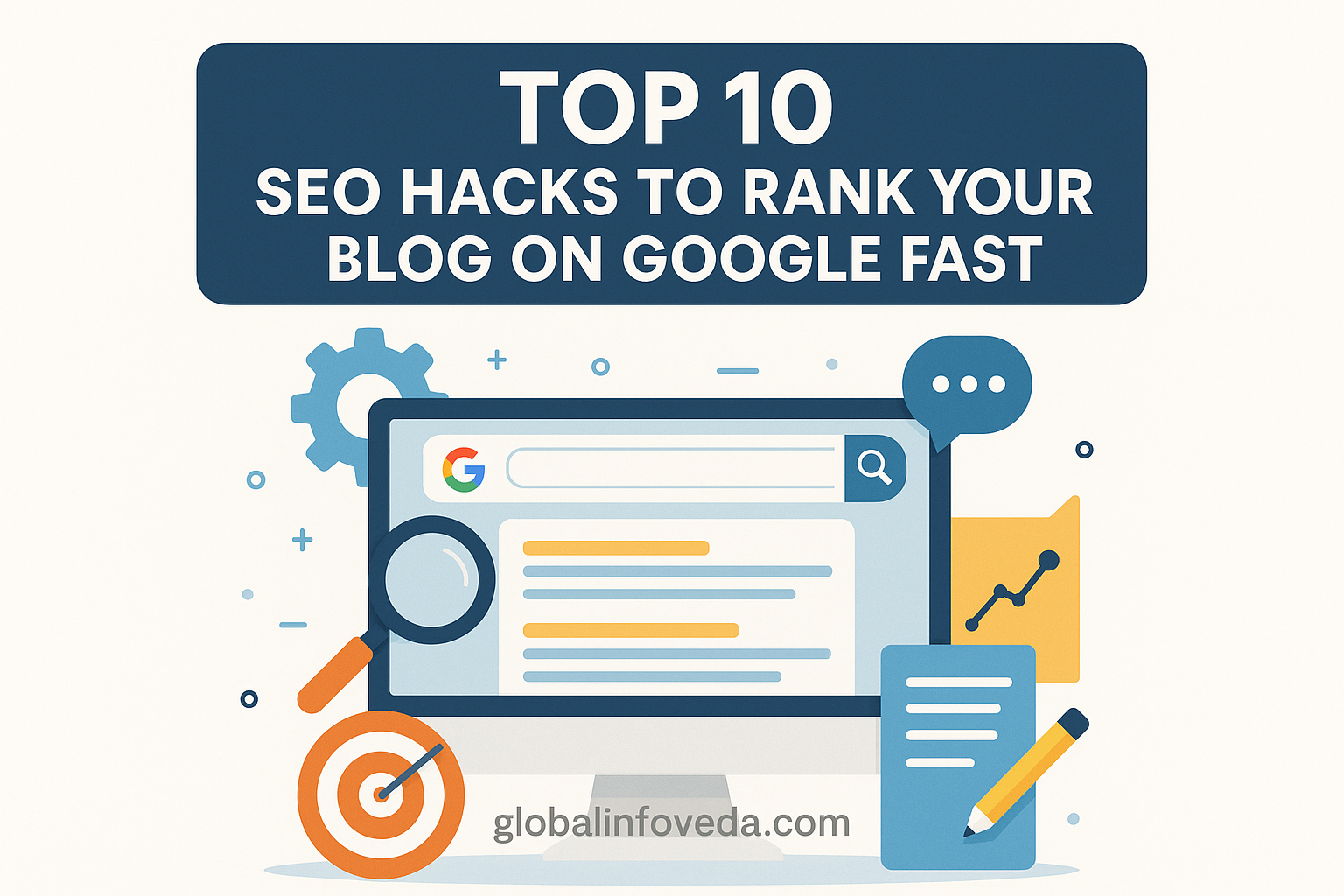🔍 Introduction
Want to get your blog seen on the first page of Google without spending years mastering SEO? You’re in the right place. Whether you’re just starting out or you’re a seasoned content creator looking for quick wins, these top 10 SEO hacks will help your blog rise in search engine rankings—quickly and effectively.
SEO isn’t just about stuffing keywords or getting backlinks anymore. It’s about providing valuable content, optimizing your user experience, and meeting search intent. These hacks are practical, beginner-friendly, and can be implemented in just a few hours to accelerate your blog’s visibility.
1. 🎯 Target Long-Tail Keywords
Long-tail keywords are specific, niche phrases that people search for with high intent. They’re easier to rank for and bring in targeted traffic.
How to Use Them:
- Use keyword tools like Ubersuggest, Google Autocomplete, AnswerThePublic, SEMrush, or Ahrefs.
- Analyze competition and focus on keywords with low keyword difficulty but decent volume.
- Use them in:
- Blog title
- Meta description
- H1, H2, and H3 headings
- URL slug
- First 100 words of your blog
- Image ALT attributes
Real-World Example:
Instead of targeting “SEO tips,” go for “easy SEO tips for new bloggers in 2025.”
Why It Works:
- Long-tail keywords have lower competition.
- Higher conversion rate due to searcher intent.
- Google ranks helpful, specific content higher.
2. 🧠 Write for Humans, Optimize for Search
User experience matters more than keyword stuffing. Google’s algorithm tracks how users interact with your content.
Write for Humans:
- Use natural language.
- Break up content with headings, bullet points, and short paragraphs.
- Provide clear answers to questions your readers might ask.
Optimize for Search:
- Use semantically related keywords (LSI keywords).
- Place main keywords strategically: title, intro, headings, and conclusion.
- Use schema markup for rich snippets.
Tools to Use:
- Hemingway Editor (for clarity and reading level)
- Grammarly (for grammar and tone)
- Surfer SEO (for keyword density and structure)
Pro Tip:
Add a FAQ section using structured data to increase chances of appearing in Google’s Featured Snippet box.
3. 🖼️ Optimize Your Images for SEO
Visual content is great—but only if it’s optimized for speed and discoverability.
Optimization Checklist:
- Descriptive filenames (e.g., “seo-hacks-featured-image-2025.png”)
- Keyword-rich ALT text
- Title and caption (when relevant)
- WebP format for smaller file size and faster loading
- Compress with TinyPNG, Kraken.io, or ShortPixel
Bonus:
Use original infographics to gain backlinks and get featured in roundups.
4. 🔗 Internal Linking Boosts Authority
Smart internal linking improves your site’s crawlability, boosts session duration, and passes link equity.
Internal Linking Strategy:
- Add 3–5 internal links in each blog post
- Link related topics using descriptive anchor text
- Update older posts with links to new content
Tools:
- Link Whisper (WordPress plugin)
- Ahrefs Site Audit (to find orphan pages)
5. 🧭 External Links to Trusted Sources
Google trusts websites that link to other trustworthy, relevant sources.
Best Practices:
- Link to .gov, .edu, and industry leader blogs (Moz, Neil Patel, HubSpot)
- Cite recent studies or authoritative articles
- Use “nofollow” for affiliate or sponsored links
Tip:
External links should open in new tabs to retain your visitors.
6. ⏱️ Page Speed Optimization
Slow websites frustrate users and reduce SEO performance.
Optimization Steps:
- Compress images and remove unused CSS
- Use a fast WordPress theme like Astra or GeneratePress
- Minify files using Autoptimize or WP Rocket
- Enable lazy loading for images and videos
Speed Testing Tools:
- Google PageSpeed Insights
- GTmetrix
- Pingdom Tools
7. 📱 Ensure Mobile-First Design
Google uses mobile-first indexing, which means your mobile performance affects your rankings.
Mobile Optimization Tips:
- Use responsive themes
- Ensure buttons are tappable
- Avoid full-screen popups
- Prioritize content above the fold
Tools:
- Google Mobile-Friendly Test
- BrowserStack to preview on multiple devices
8. 📝 Craft Magnetic Meta Titles & Descriptions
First impressions matter. Your meta title and description can determine your click-through rate (CTR).
Crafting Best Practices:
- Include the focus keyword at the beginning
- Use curiosity, urgency, or benefit-driven language
- Keep the title under 60 characters
- Keep the meta description under 155 characters
Example:
Instead of “Blog SEO Tips,” try “10 Proven SEO Hacks to Rank #1 in 2025 (Even If You’re a Beginner)”
9. 🔁 Regularly Update Old Content
Google prefers fresh and accurate content. Keep your blog posts up to date to stay competitive.
How to Update:
- Refresh stats, links, and examples
- Add new sections or FAQs
- Update visuals and screenshots
- Improve structure for readability
- Change publish date and reindex using Google Search Console
Frequency:
- Review evergreen posts every 3–6 months
- Use analytics to spot declining pages
10. 📊 Use Google Search Console Strategically
Google Search Console is your direct line to how your site performs on Google.
Key Features:
- See top-performing keywords (under Performance)
- Check impressions vs. clicks (CTR)
- Monitor indexing issues and fix them
- Submit updated sitemaps
- Get alerts about mobile usability problems
How to Use for SEO:
- Identify queries with high impressions but low CTR
- Rewrite titles and meta descriptions to improve CTR
- Optimize underperforming pages for discovered queries
🎉 Final Thoughts
You don’t need to be an SEO wizard or have a massive budget to rank higher on Google. Implementing just a few of these SEO hacks can lead to measurable improvements in traffic, engagement, and conversions.
Start with the most achievable: keyword targeting, image optimization, and internal linking. Then scale to more advanced tactics like schema markup and Search Console analytics.
✅ Remember: Consistency, quality, and user experience are your best SEO allies.
🌐 For more SEO guides, blogging tips, and digital growth strategies, visit GlobalInfoVeda.com
